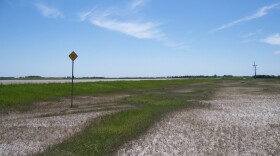If the cottonwoods in your area have not started releasing their cotton, they will be soon. It is that time of year!
It may surprise some of you, but cottonwood trees are dioecious, which means they are either male trees or female trees. The casual observer may not notice the male catkins on the male trees, or the female catkins on the female tree for that matter. But most everyone will know a female tree when the fruits open and those miniature cotton balls, each with a very small seed, start to waft away in the breeze.,
If you look closely at one of those little cotton balls, a small seed, maybe 1/16” long, is in the center of a dense tuft of silky hairs. The number of seeds a tree can produce is mind boggling. It has been estimated that a female cottonwood tree may produce around 25 million seeds in a year. Some estimates put it as high as 48 million.
The seeds of most plants native to North Dakota must go through a dormant period, often not able to germinate until the following spring or summer. Not so with cottonwood seeds -- there is no seed dormancy. The seeds are viable when dispersed, but viability drops rapidly after a week or two. So, if the seed does not quickly land on a site suitable for germination, all bets are off.
A good site for the seeds to germinate would be one where the seed lands on moist soil in full sunlight, and no vegetation nearby. Then, the young seedlings continue to need moist, exposed soil with plenty of sunlight. Drying out, and shading, for example by overtopping plants, decreases the chances of becoming established. As such cottonwoods are often associated with floodplains and sandbars along rivers and streams with spring flooding.
Cottonwood is a fast-growing tree. Seedling growth is rapid, particularly during the first three or so weeks following germination. Roots may grow to be a foot and a half deep and lateral roots two feet by the end of the first growing season. But they are still susceptible to damage from heavy rains, flooding, fungal infections (e.g., damping-off), and other factors.
If there are some cottonwoods you see on a regular basis, make a point to consider how they became established on the site. A small window of moisture, light, and other factors had to be just right for them to become established.




